#studebaker packard
Explore tagged Tumblr posts
Text

🇺🇲 On June 25, 1956, the last Packard rolled off the production line in Detroit.
🚘 Once a leading luxury car manufacturer, the Packard Motor Car Company was renowned for its square bodies and hand-finished expertise. However, after World War I, General Motors' entry into the luxury market with Cadillac began to erode Packard's market share.
🏭 In a bid to survive, Packard merged with the Studebaker Corporation in the 1950s. Despite these efforts, the struggle continued. James Nance, president of Studebaker-Packard at the time, decided to cease Packard manufacturing in Detroit.
💔 Studebaker-Packard continued to produce cars in Indiana until 1958, but the last “true Packard” is considered to be the one made in Detroit.
#brits and yanks on wheels#retro cars#transatlantic torque#vehicle#cars#old cars#brands#companies#automobile#american cars#studebacker packard corporation#studebaker packard#studebaker#packard#packard the four hundred#packard 400#detroit#michigan#american auto#automotive#luxury cars#luxury car#classic cars#classic car#car#car lovers#car enthusiasts#engine#muscle car#made in america
47 notes
·
View notes
Text
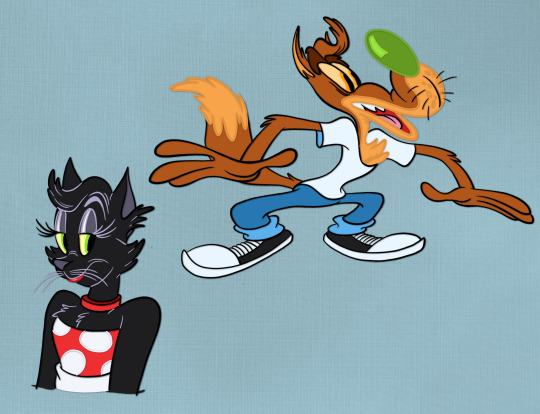
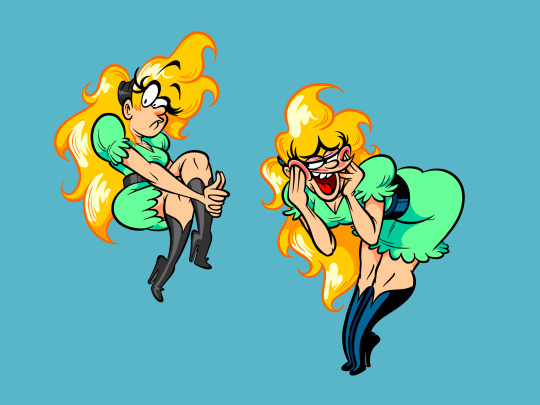


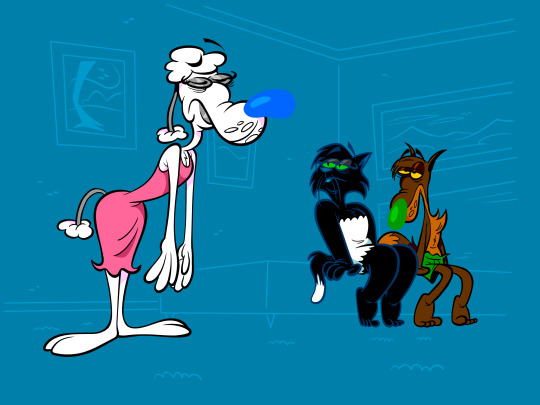
Recent dump
Including an angel design I stole from Andy Warhol
74 notes
·
View notes
Text
KR Blade having a 1920s American automobile is like Knight Rider showing up with an extremely rare Lotus Esprit and a Spyker roadster.
#where did it come from#why is it here#its either a studebaker or a packard#im leaning packard#actually fi its a fucking 6 cylinder commander WHERE did you fucking GET THAT!!!!
2 notes
·
View notes
Text
Car Spot: 1956 Packard Predictor
It might have saved Packard from extinction, the 1956 Packard Predictor is this week's spot.
The last Packard that never was I love automotive history mainly to see why certain cars were designed. Some fantastic cars never saw production like this week’s spot, the 1956 Packard Predictor. I spotted this concept car at the Studebaker Museum in South Bend, IN. The Packard name is long gone but in the early 20th century was America’s most prestigious luxury car brand by the 50s though it…
#1956 Chicago Auto Show#1956 Packard Predictor#Car Spots#car spotting#Packard#Packard autos#south bend indiana#Studebaker
1 note
·
View note
Text







I am in a sexual relationship with all cars manufactured prior to 1980.
#I love old cars#let it be known#all jokes are made in good fun#I love all these vehicles#if my spending#hours#illustrating them did not make that clear#amc rambler american#lincoln indianapolis#lamborghini miura#ford pinto#dodge charger#packard 180#studebaker dictator#procreate#illustrator#poster design#vintage cars
0 notes
Text
Classic American Automobile
#usa#blue#american cars#American automobile#studebaker#Packard#vintage#1950s#1960s#Studebaker-Packard
1 note
·
View note
Text
A Brief History of Packard
The Packard Motor Car Company was an American automobile manufacturer that operated from 1899 to 1958. James Ward Packard and William Doud Packard The company was founded in 1899 by James Ward Packard, his brother William, and a partner named George Weiss. The Packard brothers had previously built their own car and were looking to start a business manufacturing automobiles. 1916 Packard Twin…

View On WordPress
0 notes
Text





Chevrolet Aztec, 1955, by Barris Kustom. Based on a second generation Bel Air Convertible that belonged to a friend of George Barris. Together they customised the car using headlights from a 1957 Mercury Turnpike Cruiser, Packard taillights and tail fins from a Studebaker Hawk. It was displayed at numerous events and became part of the 1959 Detroit Autorama
#Chevrolet#Chevrolet Aztec#Barris Kustom#Custom car#George Barris#1955#Chevrolet Bel Air#Chevrolet Bel Air Covertible#modified car#Autorama#one-off#1950s
186 notes
·
View notes
Text

Astral Concept ('57 Studebaker-Packard)
163 notes
·
View notes
Text

1955 Chrysler Falcon Concept
In 1951, Chrysler made a strategic decision to hire Virgil Exner, which ultimately saved the company from financial ruin in the mid-1950s. Exner's innovative designs, known as the 'Forward Look,' not only revolutionized Chrysler's product line but also influenced the entire American automotive industry's shift towards modernity. While General Motors (GM) was successful during this period, Harley Earl, GM's design chief, acknowledged the need to catch up with Chrysler's designs. Ford, on the other hand, made costly mistakes, such as introducing the Edsel and discontinuing the two-seater Thunderbird, which resulted in the company playing catch-up. The other automakers, including Hudson, Nash, Studebaker, and Packard, failed to impress consumers with their designs, leading to their eventual downfall. The only exception was the Avanti, which was a well-designed car but ultimately failed in the market. In conclusion, Chrysler's strategic hiring of Virgil Exner and his innovative designs played a significant role in the company's success during the mid-1950s, while other automakers struggled to keep up with the changing times.
#Chrysler Falcon Concept#Chrysler Falcon#Chrysler#concept#falcon#car#cars#mopar#moparperformance#moparnation#moparworld
96 notes
·
View notes
Photo
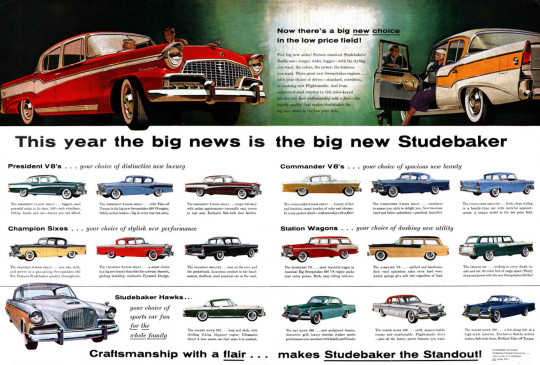
Studebaker-Packard Corp. 1956
#Studebaker#ad#1956#vintage#mid-century#automobile#advertisement#Hawk#Commander#President#cars#1950s#station wagons#mid century#V8#Flightomatic#sedan#car#Pinehurst#Parkview#illustration#advertising#midcentury
251 notes
·
View notes
Text
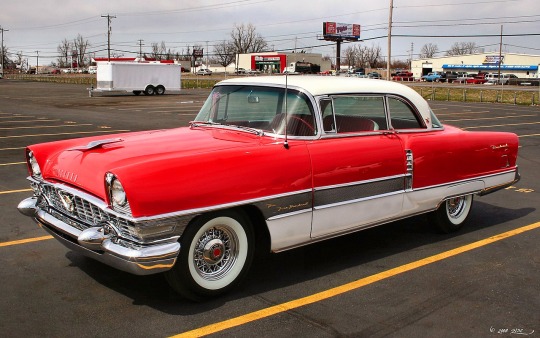

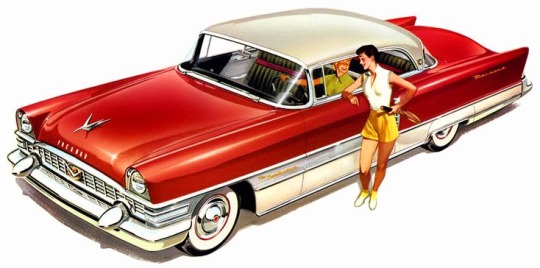


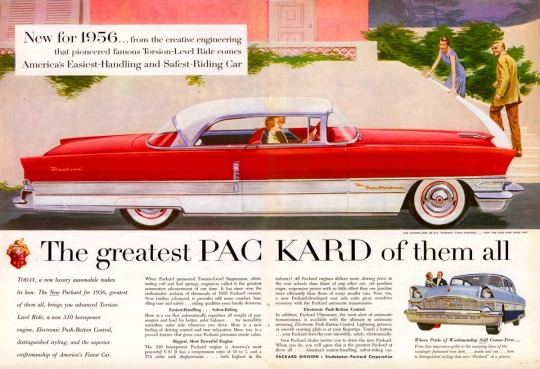




🇺🇲 Let's explore the captivating story of The Packard Four Hundred—a symbol of luxury and prestige in mid-20th century automotive history! Introduced during an era of opulence and innovation, The Packard Four Hundred captivated drivers with its exquisite design and unrivaled craftsmanship.
🚘 The Packard Four Hundred made its debut in 1955 as the flagship model of the Packard lineup, representing the pinnacle of automotive luxury and elegance. Boasting sleek lines, chrome accents, and a commanding presence on the road, it quickly became a symbol of status and sophistication.
🛞 Beneath its elegant exterior, The Packard Four Hundred showcased advanced engineering and cutting-edge technology. Equipped with a powerful V8 engine, it delivered smooth and effortless performance, while its plush interior offered unmatched comfort and refinement for passengers.
💔 Despite its initial success and acclaim, production of The Packard Four Hundred came to an end in 1958. One of the key factors contributing to its discontinuation was the changing landscape of the automotive industry, marked by increasing competition and shifting consumer preferences.
🌟 Nonetheless, The Packard Four Hundred remains a symbol of automotive excellence and craftsmanship, leaving an indelible mark on the history of American automobiles.
#brits and yanks on wheels#retro cars#transatlantic torque#vehicle#cars#old cars#brands#companies#automobile#american cars#made in america#made in usa#packard#studebacker packard corporation#studebaker packard#detroit#michigan#packard 400#packard the four hundred#1950s cars#1950s history#1950s#1950s fashion#retro#vintage#vintage cars#retro aesthetic#old car#cool cars#classic cars
15 notes
·
View notes
Text




Recent dump (Weird... it feels like there's a lot more than this)
40 notes
·
View notes
Text
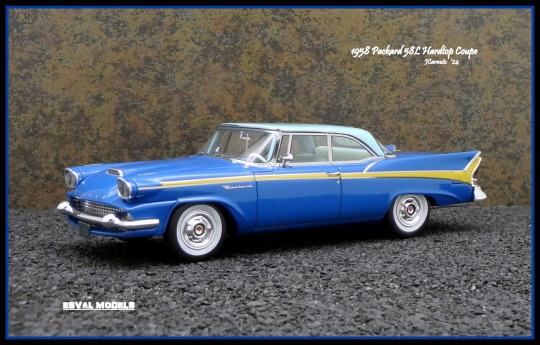

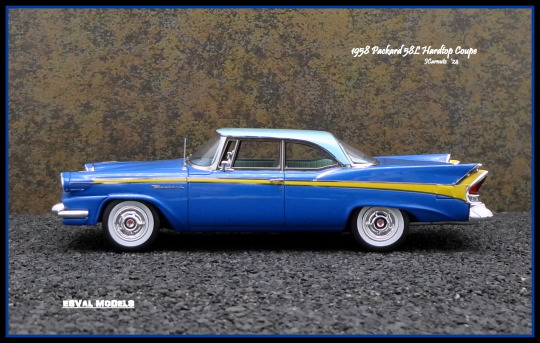



1958 Packard 58L Hardtop Coupe
Issued by Esval Models in February 2024. It is 1:43 scale and crafted in resin. A Limited Edition, 1 of 250. The model is finished in Loch Blue & Waterfall Blue (closest Studebaker-Packard colors) EMUS-43009B
4 notes
·
View notes
Text
Car Spot: 1958 Studebaker Golden Hawk
The story of a classic automotive underdog. The Studebaker Golden Hawk is this week's car spot.
Cool came too late for this car company … Being an AMC geek I’m a big fan of underdog car companies and Indiana-based Studebaker is one for sure. Studebaker and Packard merged in 1954 in an effort to survive, but the lack of resources and revenue only fueled the company’s continued decline. Just when it looked like Studebaker would never recapture its “golden touch” enter the Golden…
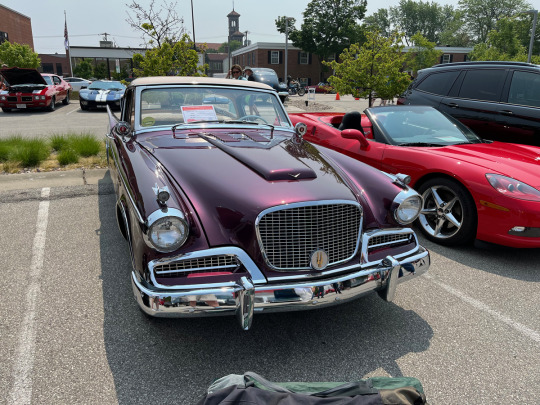
View On WordPress
#amc#Car Spots#car spotting#green bay auto gallery#Packard#Robert Bourke#Studebaker#Studebaker Golden Hawk#Studebaker Starliner
0 notes
Photo

I remember going out for dinner as a small boy with my grandmother and her boyfriend. It was a special occasion for me because my family seldom ate out but also because he had a brand new glossy black 1956 Packard Patrician and I loved cars, still do. I remember him saying it was the best Packard he had ever owned and bemoaning the fact that the company would soon be out of business. The merger with Studebaker followed shortly thereafter.
18 notes
·
View notes